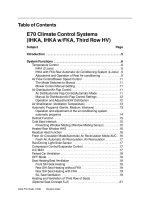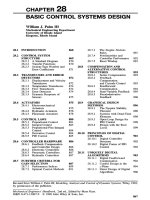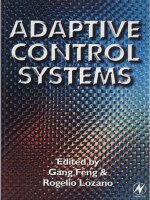Toyota training course t852 engine control systems sec04
Bạn đang xem bản rút gọn của tài liệu. Xem và tải ngay bản đầy đủ của tài liệu tại đây (2.29 MB, 16 trang )
Technician Handbook
874 Engine Control Systems II
Engine Misfire
Diagnosis
To monitor misfires, the ECM uses both the Crankshaft Position (CKP)
sensor and the Camshaft Position (CMP) sensor. The Crankshaft
Position (CKP) sensor is used to measure variations in the crankshaft
rotation speed. On the power stroke, the crankshaft accelerates. If the
cylinder misfires, the crankshaft decelerates. The Camshaft Position
(CMP) sensor is used to identify specific misfiring cylinders.
When the engine misfires, high concentrations of hydrocarbons (HC)
enter the exhaust gas. High HC concentration levels can cause
increased exhaust emission levels. High concentrations of HC can
also cause increases in the Three-Way Catalytic Converter (TWC)
temperature, which may cause damage to the TWC. To prevent this
increase in emissions and to limit the possibility of TWC thermal
damage, the ECM monitors the misfire rate.
The misfire monitor is designed to detect increases in emissions
caused by cylinder misfires, not to reduce driveability concerns.
Misfires are counted when the crankshaft rotation speed variations
exceed predetermined thresholds. When the temperature of the TWC
reaches the point of thermal degradation, the ECM blinks the MIL. If
the misfire exceeds the threshold levels, and could cause emission
deterioration, the ECM illuminates the MIL and sets a DTC.
The engine misfire monitor is a continuous monitor.
NOTE
Technical Training
The catalyst temperature is calculated by the ECM based on driving
conditions and percentage of misfire.
45
Technician Handbook
874 Engine Control Systems II
46
Technical Training
Technician Handbook
874 Engine Control Systems II
Misfire Monitor Types
A and B
Misfire Monitor Type A
There are two types of misfire monitors: Type A and B.
• A type A misfire is one that is severe enough to damage the
catalytic converter.
• The ECM will blink the MIL if the misfire will result in catalyst
temperatures of 1832 degrees F
(1000 degrees C) or more.
• The ECM will blink the MIL on the first trip that the malfunction
is detected but the MIL will not illuminate steady (DTC Stored)
until conditions are met on the 2nd trip.
• The Misfire Monitor Type A duration is based on 200 crankshaft
revolutions.
Misfire Monitor Type B
• The type B or otherwise known as an emission deterioration
misfire is less severe than the type A.
• A type B misfire will not damage the catalytic converter.
• The ECM will turn the MIL ON after two consecutive trips that
the malfunction is detected.
• The Misfire Monitor Type B duration is based on 1000
crankshaft revolutions.
Technical Training
47
Technician Handbook
874 Engine Control Systems II
Ignition Counter
The ignition counter (Ignition parameter) represents the number of
ignition events, as reported to the TIS Techstream, that have
occurred during the current ignition cycle. The ignition cycle is 1000
revolutions for most 1998 and earlier vehicles, and 200 revolutions
for most 1999 and later vehicles.
1998 and Earlier Models
The TIS Techstream will display the ignition counter recycling at
different rates based on the number of cylinders. Each cylinder in a
four-stroke engine will fire 500 times in 1000 revolutions. Therefore,
four-cylinder engines will produce 2000 ignition counts in 1000
revolutions, six-cylinder engines will produce 3000 ignition counts in
1000 revolutions, and eight-cylinder engines will produce 4000
ignition counts in 1000 revolutions.
1999 and Later Models
48
The TIS Techstream will display the ignition counter recycling at
different rates based on the number of cylinders. Each cylinder in a
four-stroke engine will fire 100 times in 200 revolutions. Therefore,
four-cylinder engines will produce 400 ignition counts in 200
revolutions, six-cylinder engines will produce
600 ignition counts in 200 revolutions, and eight-cylinder engines
will produce 800 ignition counts in
200 revolutions.
Technical Training
Technician Handbook
874 Engine Control Systems II
Misfire Data List
The Misfire Data List provides selected information related to
cylinder misfire. The Misfire Data Lists from OBD II and CAN OBD II
vehicles will be different.
Ignition
The Ignition parameter represents the ignition counter and indicates
how many ignition events (all cylinders) have occurred in the current
200 revolution cycle (1999 and later vehicles). When the ignition
counter is cycling, the misfire monitor is operating and reporting to
the TIS Techstream.
Cylinder # Misfire Rate
The Cylinder # Misfire Rate parameter indicates how many times
(0–100) the cylinder has misfired during the current ignition counter
cycle. A value above 0 indicates a misfiring cylinder. For six- and
eight- cylinder engines, the ECM may not set specific misfiring
cylinder DTC(s) at high engine RPM and may only set DTC P0300
in this condition. Diagnose the cylinder(s) with the highest Cylinder #
Misfire Rate first.
Misfire Margin
(CAN OBD II vehicles)
The Misfire Margin parameter indicates the percentage chance that
a misfire will NOT occur. A negative percentage indicates a misfire is
occurring. A high positive percentage indicates a low chance for a
misfire to occur under the current conditions.
Cat OT MF F/C
Technical Training
Catalyst OT MF F/C stands for Catalyst Over Temperature Misfire
Fuel Cut. History and individual cylinder parameter will be turned
ON when a Type A misfire is present and fuel injector(s) has been
shut down.
49
Technician Handbook
874 Engine Control Systems II
Misfire Detection
Misfire detection due to a catalyst over temperature [Data list →
Cylinder # Misfire Count]
The misfire ratio is evaluated every 200 engine revolutions, and a
DTC is detected when a misfire has taken place three times at or
above the threshold misfire ratio that causes a thermal deterioration
in the catalyst. (Two trip detection logic)
While a misfire is taking place under these conditions, the MIL
blinks, regardless of the number of trips. On some engines, the MIL
will continue to blink after the catalyst over temperature conditions
have passed. On the next key cycle, the MIL will not blink until over
temperature conditions occur in the catalytic converter.
Misfire detection for a deteriorated level of emissions [Data list
→ All Cylinder Misfire Count]
The misfire ratio is evaluated every 1,000 engine revolutions, and a
DTC is detected when a misfire has occurred at or above the
threshold misfire ratio for a judgment of emission deterioration. (Two
trip detection logic)
If this condition happens on the second consecutive trip, the MIL is
turned ON.
50
Technical Training
Technician Handbook
874 Engine Control Systems II
Misfire Monitor
The Misfire Monitor counts the number of misfires for all cylinders, individual
cylinders, and tracks average misfires from previous trips.
The ECM counts misfires and is available under misfire test details.
MISFIRE RATE – total misfire count for all cylinders
MISFIRE RATE 1 – number of misfire counts for cylinder 1
Each count represents a cylinder misfire. KOEO the test details provides the
number of misfires from the last trip. This is reset to zero after the engine
has started.
After the engine is started the previous misfire counts are averaged and stored in
the Misfire Monitor as EWMA Misfire. EWMA stands for Exponentially Weighted
Moving Average (EWMA) Misfire which represents the average number of counts
for all cylinders as well as individual cylinder misfires. This value represents 10%
of the last trip’s misfires plus 90% of the average of the previous trips.
Exponentially Weighted Moving Average (EWMA) Misfire Formula
0.1 x (current counts) + 0.9 x (previous average)
EWMA MISFIRE – total average for all cylinders
EWMA MISFIRE 1 – average for cylinder 1
The cylinder and misfire count can be useful for the following situations.
Technical Training
1.
A customer reports the check engine lights was flashing, but now it does
not flash. There is no DTC and the MIL is off. The EWMA can report which
cylinder(s) had the misfire.
2.
The vehicle has P0300 DTC. Which cylinder had the most misfires.
3.
The vehicle has a P0300 and multiple misfire DTCs. Again, which cylinder
had the highest misfire counts.
51
Technician Handbook
874 Engine Control Systems II
Duplicating Misfires
All Cylinders Misfire Count displays the total number of misfires for all
cylinders. The available range is from 0 to 255 misfire counts. This
counter line resets to zero every 1000 crankshaft revolutions.
Misfire RPM and Misfire Load populate when misfire criteria is met on
the first trip. Parameters will not update on the second trip but Freeze
Frame Data will be saved for the Current DTC. This information can
be very useful in determining vehicle operating conditions while
misfires were taking place.
To duplicate an engine misfire, use the Misfire RPM and Misfire Load
values from the Engine Live Misfire data list. Reference the Freeze
Frame data to duplicate engine operating conditions, such as
calculated load, coolant temperature, etc., at the time the DTC set.
Unfortunately, Misfire Load is displayed in g/rev (grams per
revolution) and is derived from the MAF signal. To convert g/rev to
gm/sec follow the procedure below:
1. Divide Misfire RPM by 60 sec to get Revolutions per Second
2. Multiply Revolutions per Seconds by Misfire Load (g/rev) to get
grams per second (g/sec)
•
Example: Misfire RPM shows 2275 RPM and Misfire Load
shows 0.28 g/rev
2275rpm/60=38Hz; 38Hz * 0.28g/rev=10.64 g/sec
The misfire was detected at 2275 RPM with a MAF Sensor signal of
10.64 g/sec.
52
Technical Training
Technician Handbook
874 Engine Control Systems II
Misfire Margin
Misfire Margin is the difference between the predicted change in
crankshaft rotation speed represented electronically by NE signal to
the actual change in the NE signal.
The Misfire Margin will move towards the negative region when
misfires are detected. If it is under 30% there is a chance misfire is
occurring. If it is in the negative zone, misfire is occurring.
This parameter is useful for it will change as the chance of a misfire
increases. When trying to duplicate the misfire conditions, the
misfire margin percentage will decrease as the engine nears or
experiences cylinder misfire.
Technical Training
53
Technician Handbook
874 Engine Control Systems II
Single Cylinder
Misfire Diagnosis
Use the following steps to diagnose a single cylinder misfire
(examples based on DTC P0302):
1. Duplicate the misfire using Engine Live and Freeze Frame data.
2. Compare the spark plug firing tip of the misfiring cylinder to spark
plug firing tips from cylinders with no misfires present.
3. Swap the igniter from the misfiring cylinder to a different cylinder
with no misfires present
(swap the igniter with cylinder # 4).
4. Swap the spark plug from the misfiring cylinder to a separate
different cylinder with no misfires present (swap the spark plug
with cylinder # 6).
5. If the misfire moves to a cylinder with a swapped component,
replace the component
(e.g. if cylinder # 4 begins to misfire, replace the igniter, etc.).
6. If the misfire stays with the original cylinder, check the cylinder
compression pressure and fuel delivery.
NOTE
54
The diagnostic procedure outlined here is for training purposes only
and may not be effective for every issue. Always refer to Service
Bulletins (SB) and Repair Manuals (RM) for information on specific
vehicles and issues.
Technical Training
Technician Handbook
874 Engine Control Systems II
Compression Test
Proper cylinder compression pressure verifies the misfire is not
related to mechanical components.
When performing a cylinder compression pressure test, fuel
injection and ignition must be turned OFF. The procedure to turn
OFF the fuel injection and ignition, as well as check the
compression, varies with vehicle model. Always refer to the vehicle
Repair Manual for the proper cylinder compression pressure test
procedure and pressure specifications.
Active Test
Technical Training
Performing a Cylinder Compression active test (some 2005 and
later model vehicles) will turn OFF fuel injection and ignition so that
a compression pressure test can be performed. While this active
test may be available, the Repair Manual cylinder compression
pressure inspection procedure may not utilize it. The fastest way to
find out if a Cylinder Compression active test can be performed on a
specific vehicle is to check the active tests available within the ECM
using the Techstream by clicking Active Test from the Engine Live
main menu. Performing this active test, if available, will allow a
cylinder compression pressure test to be performed without
disconnecting all fuel injector connectors and/or removing the EFI
fuse or circuit opening relay.
55
Technician Handbook
874 Engine Control Systems II
Cylinder Speed
Data List
Some 2006 and later model vehicles will display the speed of each
cylinder. During a Cylinder Compression active test with all spark
plugs installed, if a single cylinder is rotating faster than other
cylinders, this may indicate a mechanical issue with that cylinder.
In the illustration, the spark plug was removed from cylinder number
4 and a Cylinder Compression active test was performed.
NOTE
56
It may be necessary to crank the engine for up to 20 seconds before
accurate Engine Speed of Cyl # readings populate.
Technical Training
Technician Handbook
874 Engine Control Systems II
Multiple Cylinder
Misfire Diagnosis
Misfires can be the result of other system malfunctions. If other system
DTC(s) are present, diagnose those DTC(s) / systems first.
If multiple cylinder misfires are present, check for commonalities between
cylinders. Some commonalities include fuel, mechanical issues, inputs,
and outputs.
Fuel
Mechanical
Broken or misadjusted valve train components, incorrect valve timing and
carbon buildup are some possible mechanical issues that may cause multiple
cylinder misfires.
Inputs
Some inputs that may cause multiple cylinder misfires include the crankshaft
position sensor, camshaft position sensor, engine coolant temperature sensor,
intake air temperature sensor, A/F and/or O2 sensors, and the MAF sensor.
Outputs
Technical Training
Improper fuel pressure, restricted injectors, restrictions in the fuel line,
incorrect fuel such as E-85 or diesel, or water in the fuel are all possible fuel
issues that may cause multiple cylinder misfires.
Some outputs that may cause multiple cylinder misfires include fuel trim and
valve timing (VVT-i).
NOTE
Rough roads, oversized wheels, etc. may also cause multiple cylinder
misfires. It is very important to talk to the customer and understand the actual
driving conditions when the misfire DTC(s) occurred.
NOTE
If several cylinders are misfiring, drive the system rich (+25) with an Injector
Volume or A/F Control active test. If the misfiring cylinders stop misfiring, this
may indicate restricted injectors for these cylinders.
NOTE
If all cylinders but one on a single bank are misfiring, check fuel trims. If the
fuel trims for the misfiring bank are in the double-digit negatives, perform an
Injector Volume active test and drive the system rich (+25%). If the misfiring
cylinders stop misfiring, this may indicate a leaking injector in the cylinder that
was not misfiring. The cylinder with the leaking injector may actually start to
misfire with the injection volume commanded rich (+25%). This may apply to
single cylinder misfires on four-cylinder engines with two banks.
57
Technician Handbook
874 Engine Control Systems II
IGF Fail-Safe
There are different fail-safe modes depending on the type of ignition
system, cylinder displacement, and model year. The following is a
general summary.
• If there is no IGF signal on engines before 1998 model year,
the ECM will enter fuel fail-safe and turn off all the fuel
injectors.
• Beginning with the 1998 model year, for V-6 and V-8 engines
equipped with direct ignition system with integrated ignition
coil/igniter (1 ignition coil/igniter per cylinder), the engine will
still run without the IGF signal, but the MIL will be ON.
• Beginning with the 2001 model year on 1 ignition coil/igniter
per cylinder engines, the ECM fail-safe will turn off the fuel
injector if there is no IGF signal for that cylinder and if engine
conditions (such as load and temperature) are sufficient to
damage the catalytic converter. If the IGF signal returns to
normal while the engine is running, the injector may remain off
until the next engine start.
NOTE
58
Some vehicles will disable specific cylinder fuel injectors if a misfire
is detected. Always clear DTCs and confirm injector operation.
Technical Training
Technician Handbook
874 Engine Control Systems II
Technical Training
59
Technician Handbook
874 Engine Control Systems II
60
Technical Training









